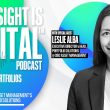Compared With Other Countries, U.S. Health Care Looks Sick
by Carl Tannenbaum, Asha Bangalore, Northern Trust
SUMMARY
- Compared With Other Countries, U.S. Health Care Looks Sick
- Universal Basic Income: A Utopian Idea Under Test
- New Rules for U.S. Overtime Pay
Health care was a major campaign issue in the last four election cycles. It is too early in the game to determine whether health care becomes the defining issue this time around. But it will certainly have a very prominent place for many reasons in public debates as Election Day draws closer.
Cross-national health care data paint the United States in negative light. The latest Organization for Economic Cooperation and Development (OECD, a group of 34 countries) report on health care provides a wealth of information to assess the U.S. health care system across a broad spectrum of health care metrics.
From a macroeconomic standpoint, U.S. health care spending is by far a larger share of gross domestic product than other high-income countries, even though the United States has a smaller elderly population.
U.S. per capita health care expenditures exceed the OECD average by a large measure. The United States spends 37% more than Switzerland on health care per capita, the next-highest spender. The difference is significantly larger compared with the OECD average.
High health care spending contributes to personal bankruptcy, budget deficits and places the United States at a competitive disadvantage in the global economy.
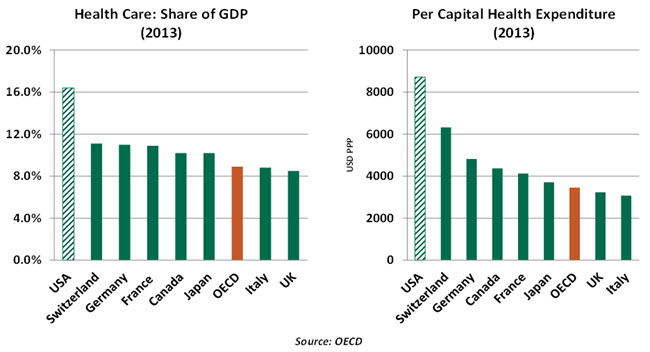
Moving from the forest to the trees, specific health care performance data offer another side of the status of the U.S. health care system.
Notwithstanding the high spending on health care, the health of the U.S. population is poor. Three measures shed light on this observation. Life expectancy in the United States at birth (78.7 years) is lower than the OECD average. The infant mortality rate exceeds the OECD average. Infant mortality is an important indicator of a nation's health because it reflects factors such as maternal health, quality and access to medical care, socioeconomic conditions and public health practices. A larger percentage of American adults aged 65 or older have chronic diseases versus others in the peer group.
Research indicates that social and economic factors such as education, employment, income, family and social support and community safety account for about 40% of health outcomes. Excluding socioeconomic factors, the Institute of Medicine finds that even the affluent, non-smoking, non-obese segments of U.S. population appear to be in poor health relative to their counterparts abroad. The United States places poorly on a variety of metrics such as diabetes care, mortality following heart attacks and stroke.
Data from the International Federation of Health Plans show that hospital and physician prices of procedures were highest in the United States in 2013. Other studies have shown that widely used medicines were the most expensive in the United States.
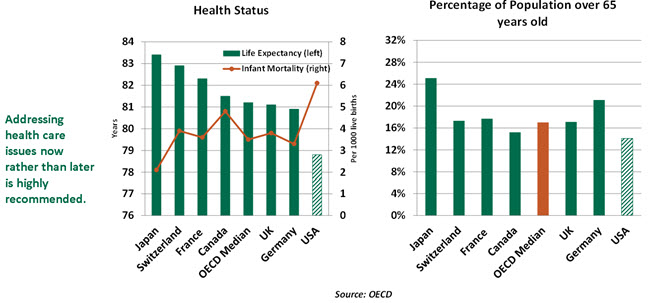
Nonetheless, there are redeeming features in the health care system. Out-of-pocket medical expenses as a percent of consumer household consumption in the United States (2.6%) is less than the OECD (2.8%) average. The United States is the center for development of new medicines and medical technology.
There are simple ways to improve the current system. We could encourage preventive medicine, increase the maintenance of electronic medical records, and provide incentives to adopt a healthy life style. We could enhance consumers' understanding of how medical procedures are billed so that they are well-informed to make decisions.
More importantly, there is a pressing need to fix the U.S. health care structure, given the gaping shortcomings. The two frontrunners in the upcoming presidential elections present vastly different strategies.
Donald Trump, the Republican nominee, published a seven-point plan that is based on "free- market principles." He would repeal the Affordable Care Act (ACA), reduce barriers to the interstate sale of health insurance and put in place a full tax reduction for insurance payments for individuals. He also would make Health Savings Accounts inheritable, require price transparency, block-grant for Medicaid to states and allow for more drug providers through lowered regulatory barriers.
On the other side of the aisle, the presumptive Democratic nominee, Hillary Clinton, would retain the ACA and proposes to allow Americans to buy into Medicare before age 65, the current age to receive health care coverage under the program. Her platform includes a range of other programs, including those for autistic persons and provisions to combat Alzheimer's disease. Bernie Sanders advocates a single-payer health plan.
Irrespective of opinions about ACA, dismantling it would cause serious disruptions. There are about 10 million people covered under ACA, and most of them receive subsidies. In addition, the 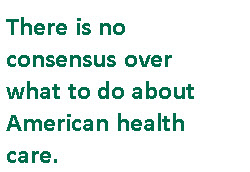 Medicare expansion under ACA extended health insurance to 12 million people. Private health insurers invested large amounts to participate and comply with ACA. Eliminating the ACA would result in short-run operational challenges for these firms. Needless to say, interrupting these programs without a clear alternative plan would be truly problematic.
Medicare expansion under ACA extended health insurance to 12 million people. Private health insurers invested large amounts to participate and comply with ACA. Eliminating the ACA would result in short-run operational challenges for these firms. Needless to say, interrupting these programs without a clear alternative plan would be truly problematic.
At the heart of the health care debate is the tug-of-war between costs and outcomes. Costs in the United States are holding at a high level; consequently, the cost-benefit equation in the American health care system is highly unfavorable. The demographic transformation of the U.S. population makes the problem more complex.
It is important to note that political actions - rather than market actions - will determine the future course of health care finance and delivery. Finding a path forward will be critical for the next president and Congress.
Income Without Work
Switzerland, a prosperous advanced economy, will hold the world's first referendum on Universal Basic Income (UBI) on June 5. It is an idea that addresses fear about automation leading to severe job losses. Even if the plebiscite's outcome fails to favor UBI, discussion of its suitability will continue.
In the current vintage, UBI is an unconditional payment to everyone by the state. The numbers (in US dollars) cited in the Swiss case are $2,600 per adult and $625 per child each month. The Netherlands, Spain and Canada are examining similar proposals. Finland plans to give 10,000 people around $625 a month to replace existing welfare benefits.
The UBI concept is not new. Thomas Moore, a 15th-century thinker, introduced the minimum income concept, and Thomas Paine developed it further in the 18th century. In modern times, Milton Friedman championed a negative income tax, where the state would give a set amount of money to an individual without income, and it would decline by a fraction as the person's income increased. Negative income tax is a streamlined replacement for welfare programs that require a large bureaucracy to administer.
The U.S. Congress adopted a modified version of negative income tax, Earned Income Tax Credit, which only people who are employed receive. The UBI program differs, as it covers the unemployed and aims to replace existing welfare programs.
In the 1970s and 1980s, Canada and the United States tried several other short-lived experiments to guarantee income. The Alaska Permanent Dividend Fund pays a share of its annual revenue to each resident. Some Middle Eastern oil exporters provide assistance to citizens. Both programs can be considered as forms of basic income.
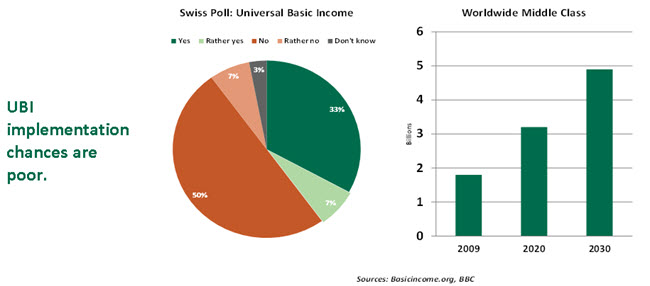
Anxiety about technological improvement and unemployment is old. In 1930, John Maynard Keynes wrote:
"We are being afflicted with a new disease of which some readers may not yet have heard the name, but of which they will hear a great deal in the years to come--namely, technological unemployment. This means unemployment due to our discovery of means of economising the use of labour outrunning the pace at which we can find new uses for labour."
There are two fundamental questions to keep in mind when considering how to make a UBI program successful: (1) How to expand support without undermining work incentives and (2) how to finance the program. The Swiss have not figured this out yet.
It is a challenge to present a convincing case to skeptics who believe that recipients will abuse the UBI program. The typical retort is that the digital economy does not provide enough compensating jobs to replace employment automated out of existence. Therefore, people with low skills will drop out of the labor force permanently, and prevention of poverty is essential.
Doubters dismiss fears of job losses and note that the world's middle-class population is projected to grow in the years ahead, implying that UBI is unnecessary. Substantial industrial shifts throughout history raised fears of persistent unemployment, but flexible labor markets always allowed a successful transition without inordinate amounts of state assistance.
A middle-of-the-road approach would recognize that industrial changes are part and parcel of a changing economy. If the objective is to maintain and expand a middle-class society, modern governments will need programs in place that address unanticipated labor market fallout from technological developments.
The UBI program is an intriguing idea. But the cost to implement it is staggering. There is lively debate about this concept, and experiments are underway. It will be a long time before robots eventually take care of most of our work, so UBI until then will remain a Utopian idea.
Fix for Underpaid Overtime
Last week, the U.S. Department of Labor (DOL) announced a change in rules for overtime pay. The implications of the increase in overtime pay in terms of employment and costs appear to be modest.
The DOL's new rule nearly doubles the threshold for workers exempt from overtime pay to $913 ($47,476 per year) per week from $455 ($23,660 per year), effective December 2016. Employers must pay workers making less than the new threshold 150% of their normal pay for hours that exceed 40 hours per week.
The increase restores the threshold (after adjusting for inflation) to levels seen in the 1970s. The DOL estimates the rule will affect 4.2 million workers in the country. Of these, 61% are over 35 years old, and 53% hold a bachelor's degree.
The new threshold will be adjusted for inflation every three years. The current administration's projections of wage growth point to an increase rise to more than $51,000 with the first update on January 1, 2020.

The net impact on employment is tied to how employers will react to the change in overtime pay. It would cost employers less to compensate at or above the threshold and assign extra hours of unpaid overtime than to pay below the threshold and incur time-and-a-half expenses.
Employers could limit the hours of affected workers to 40 hours and increase payrolls to address the rest of the hours at the normal pay without overtime. The DOL estimates new rules will increase aggregate pay by $1.2 billion per year (those earning between $455 and $913), which will help to raise incomes of middle-income workers. Inflation-adjusted median family income is below the 1999 peak. Alternatively, raising overtime costs could speed the pace of offshoring or automation.
The recent overtime pay rule is one way to reduce income inequality, and it could be constructive for consumer spending.

